Strategic Management Report: Coco-cola's Market Analysis and Strategy
VerifiedAdded on 2020/02/18
|17
|3985
|48
Report
AI Summary
This report provides a detailed analysis of Coca-Cola's management strategy, examining its organizational efficiencies, mission, resources, and capabilities. It explores Coca-Cola's cost leadership and product differentiation strategies, alongside industry analysis using Porter's Five Forces model, assessing competitive forces, buyer power, supplier power, the threat of substitution, and new entrants. The report also incorporates Waterman's 7-S framework to evaluate the company's strategy, structure, systems, shared values, skills, style, and staff. Furthermore, it includes a Porter value chain analysis to assess the company's structure across various aspects, such as inbound and outbound logistics and marketing. The objective is to evaluate Coca-Cola's current market position and customer expectations, culminating in recommendations and conclusions about the company's strategic approach and market performance.

RUNNING HEAD: Management Strategy
Management strategy
Coco-cola
Management strategy
Coco-cola
Paraphrase This Document
Need a fresh take? Get an instant paraphrase of this document with our AI Paraphraser
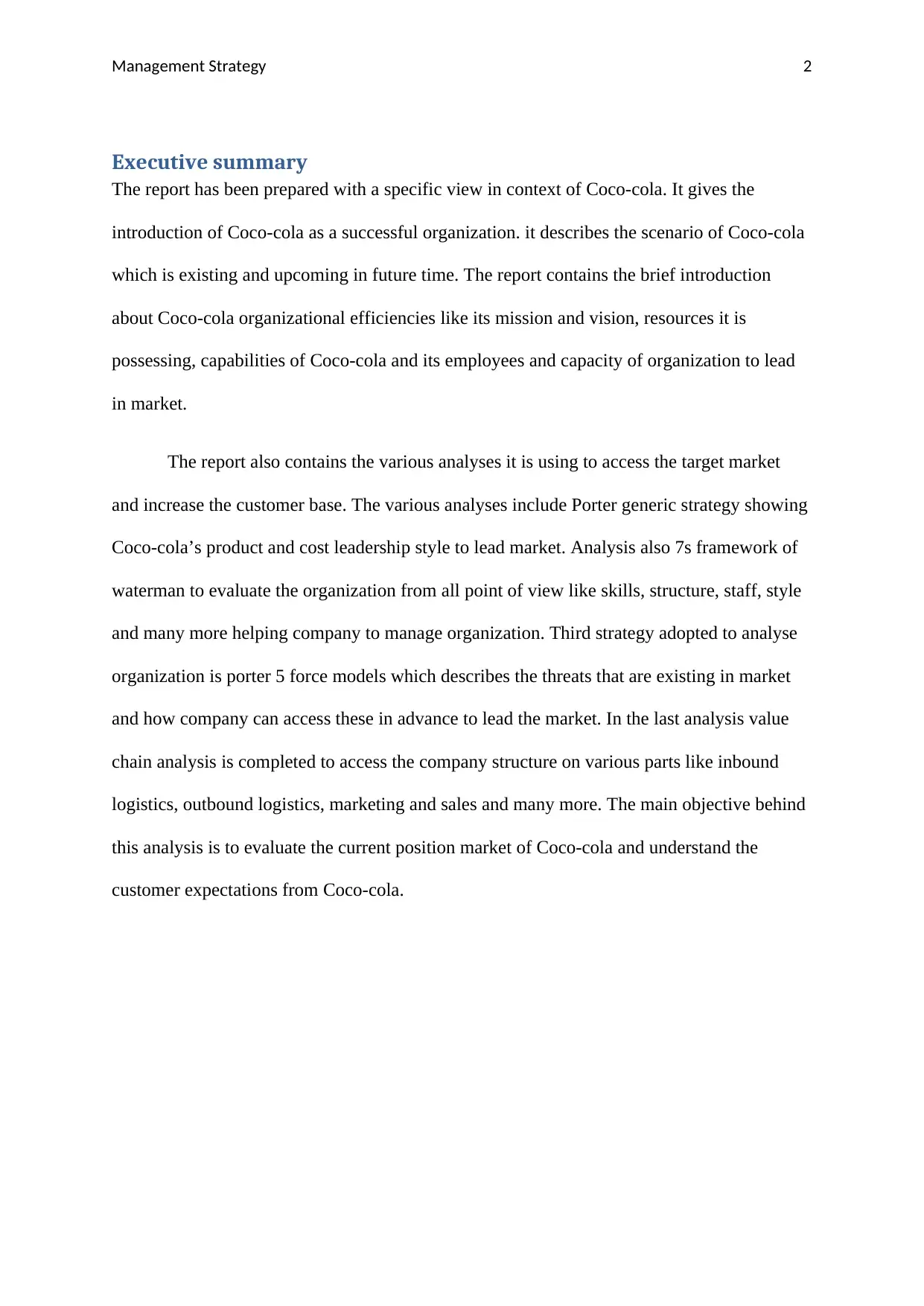
Management Strategy 2
Executive summary
The report has been prepared with a specific view in context of Coco-cola. It gives the
introduction of Coco-cola as a successful organization. it describes the scenario of Coco-cola
which is existing and upcoming in future time. The report contains the brief introduction
about Coco-cola organizational efficiencies like its mission and vision, resources it is
possessing, capabilities of Coco-cola and its employees and capacity of organization to lead
in market.
The report also contains the various analyses it is using to access the target market
and increase the customer base. The various analyses include Porter generic strategy showing
Coco-cola’s product and cost leadership style to lead market. Analysis also 7s framework of
waterman to evaluate the organization from all point of view like skills, structure, staff, style
and many more helping company to manage organization. Third strategy adopted to analyse
organization is porter 5 force models which describes the threats that are existing in market
and how company can access these in advance to lead the market. In the last analysis value
chain analysis is completed to access the company structure on various parts like inbound
logistics, outbound logistics, marketing and sales and many more. The main objective behind
this analysis is to evaluate the current position market of Coco-cola and understand the
customer expectations from Coco-cola.
Executive summary
The report has been prepared with a specific view in context of Coco-cola. It gives the
introduction of Coco-cola as a successful organization. it describes the scenario of Coco-cola
which is existing and upcoming in future time. The report contains the brief introduction
about Coco-cola organizational efficiencies like its mission and vision, resources it is
possessing, capabilities of Coco-cola and its employees and capacity of organization to lead
in market.
The report also contains the various analyses it is using to access the target market
and increase the customer base. The various analyses include Porter generic strategy showing
Coco-cola’s product and cost leadership style to lead market. Analysis also 7s framework of
waterman to evaluate the organization from all point of view like skills, structure, staff, style
and many more helping company to manage organization. Third strategy adopted to analyse
organization is porter 5 force models which describes the threats that are existing in market
and how company can access these in advance to lead the market. In the last analysis value
chain analysis is completed to access the company structure on various parts like inbound
logistics, outbound logistics, marketing and sales and many more. The main objective behind
this analysis is to evaluate the current position market of Coco-cola and understand the
customer expectations from Coco-cola.
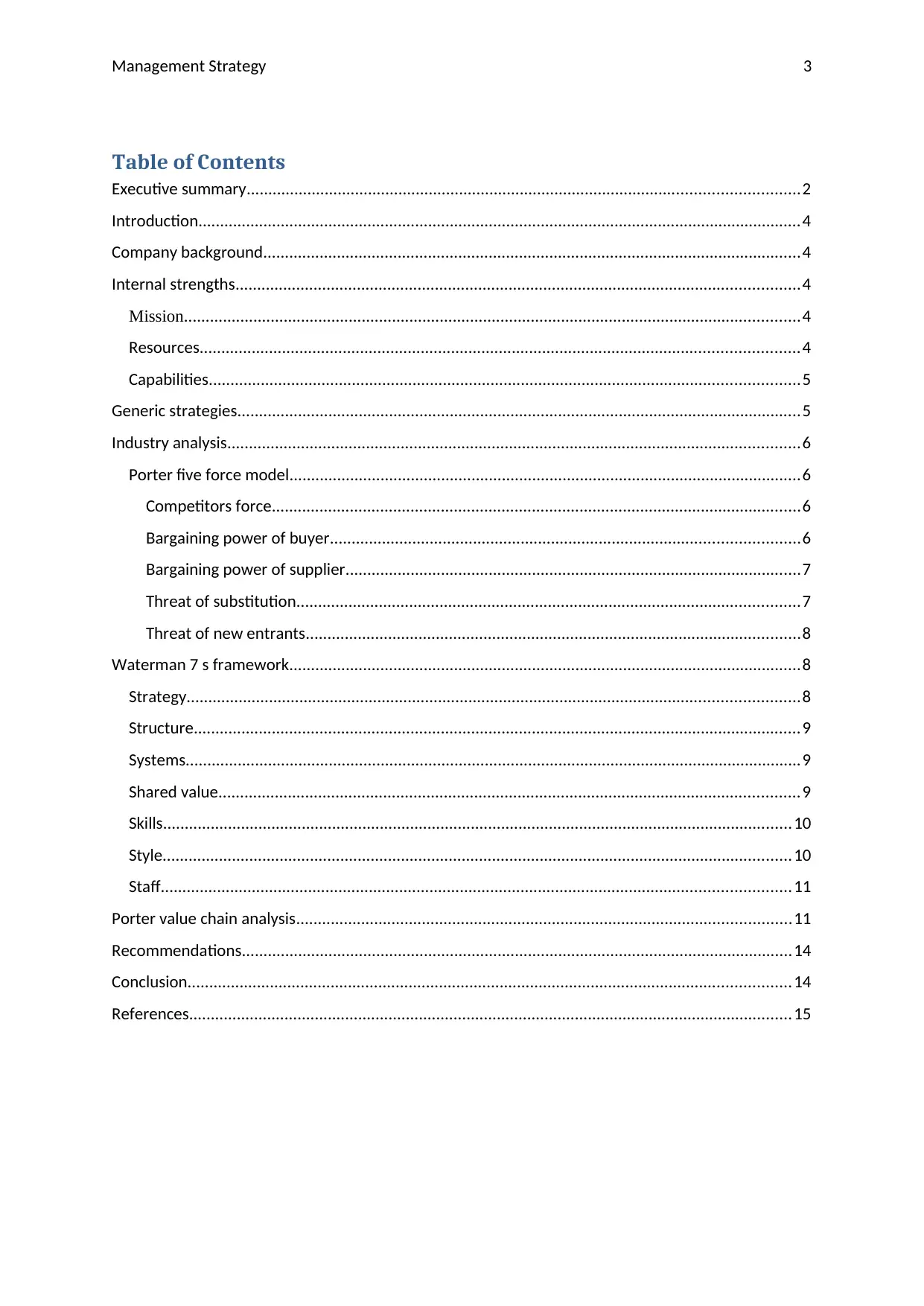
Management Strategy 3
Table of Contents
Executive summary...............................................................................................................................2
Introduction...........................................................................................................................................4
Company background............................................................................................................................4
Internal strengths..................................................................................................................................4
Mission..............................................................................................................................................4
Resources..........................................................................................................................................4
Capabilities........................................................................................................................................5
Generic strategies..................................................................................................................................5
Industry analysis....................................................................................................................................6
Porter five force model......................................................................................................................6
Competitors force..........................................................................................................................6
Bargaining power of buyer............................................................................................................6
Bargaining power of supplier.........................................................................................................7
Threat of substitution....................................................................................................................7
Threat of new entrants..................................................................................................................8
Waterman 7 s framework......................................................................................................................8
Strategy.............................................................................................................................................8
Structure............................................................................................................................................9
Systems..............................................................................................................................................9
Shared value......................................................................................................................................9
Skills.................................................................................................................................................10
Style.................................................................................................................................................10
Staff.................................................................................................................................................11
Porter value chain analysis..................................................................................................................11
Recommendations...............................................................................................................................14
Conclusion...........................................................................................................................................14
References...........................................................................................................................................15
Table of Contents
Executive summary...............................................................................................................................2
Introduction...........................................................................................................................................4
Company background............................................................................................................................4
Internal strengths..................................................................................................................................4
Mission..............................................................................................................................................4
Resources..........................................................................................................................................4
Capabilities........................................................................................................................................5
Generic strategies..................................................................................................................................5
Industry analysis....................................................................................................................................6
Porter five force model......................................................................................................................6
Competitors force..........................................................................................................................6
Bargaining power of buyer............................................................................................................6
Bargaining power of supplier.........................................................................................................7
Threat of substitution....................................................................................................................7
Threat of new entrants..................................................................................................................8
Waterman 7 s framework......................................................................................................................8
Strategy.............................................................................................................................................8
Structure............................................................................................................................................9
Systems..............................................................................................................................................9
Shared value......................................................................................................................................9
Skills.................................................................................................................................................10
Style.................................................................................................................................................10
Staff.................................................................................................................................................11
Porter value chain analysis..................................................................................................................11
Recommendations...............................................................................................................................14
Conclusion...........................................................................................................................................14
References...........................................................................................................................................15
⊘ This is a preview!⊘
Do you want full access?
Subscribe today to unlock all pages.

Trusted by 1+ million students worldwide
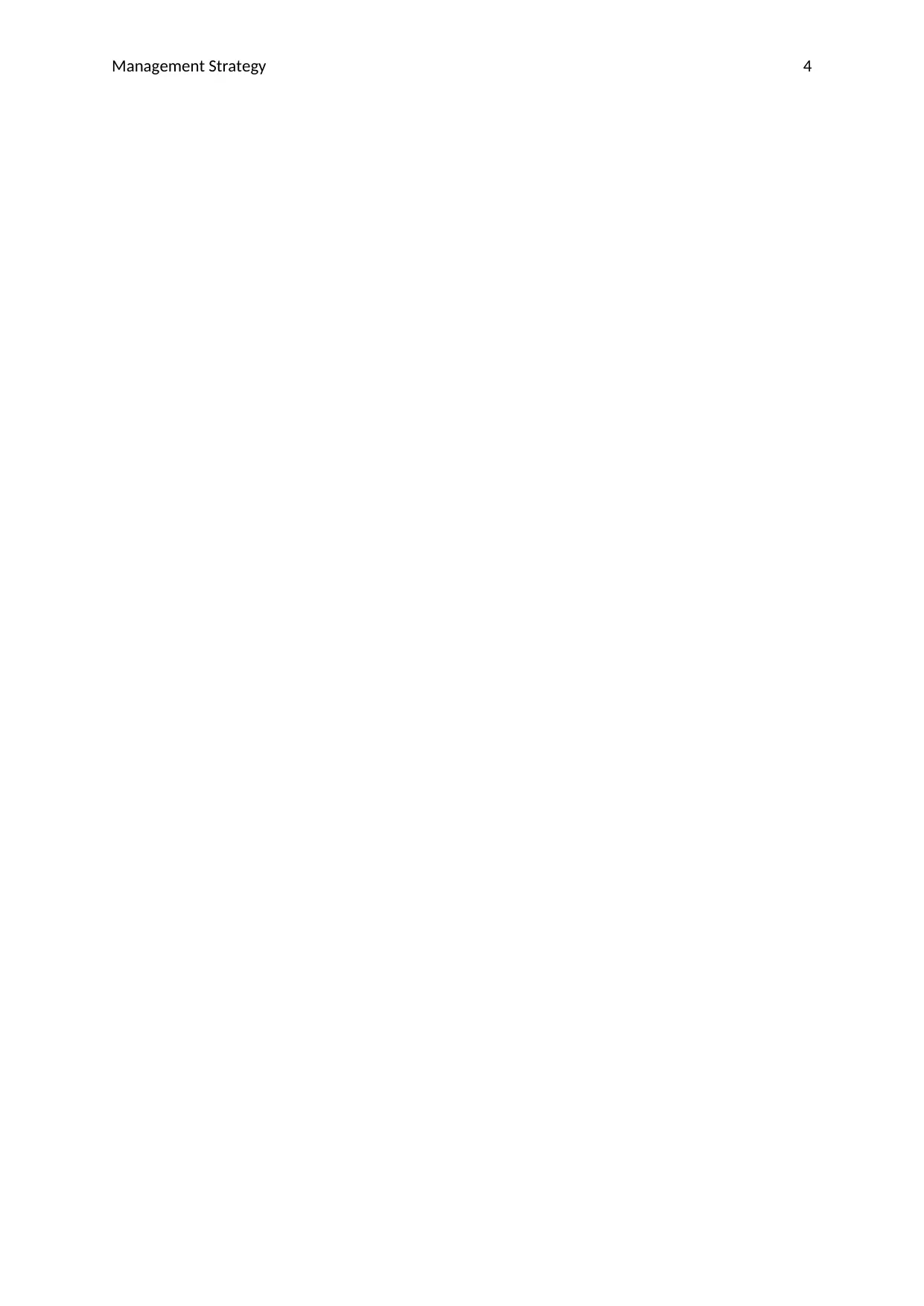
Management Strategy 4
Paraphrase This Document
Need a fresh take? Get an instant paraphrase of this document with our AI Paraphraser
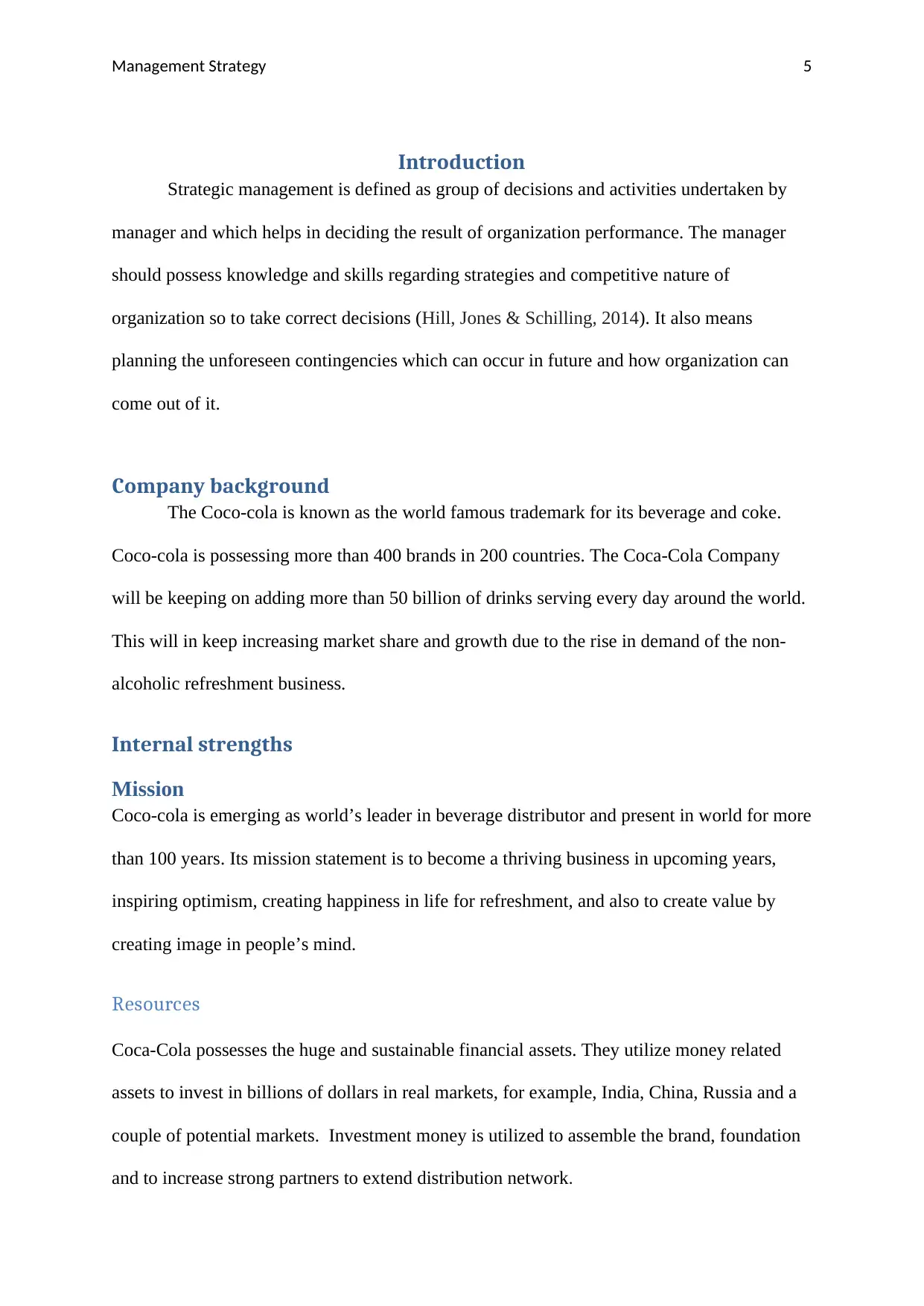
Management Strategy 5
Introduction
Strategic management is defined as group of decisions and activities undertaken by
manager and which helps in deciding the result of organization performance. The manager
should possess knowledge and skills regarding strategies and competitive nature of
organization so to take correct decisions (Hill, Jones & Schilling, 2014). It also means
planning the unforeseen contingencies which can occur in future and how organization can
come out of it.
Company background
The Coco-cola is known as the world famous trademark for its beverage and coke.
Coco-cola is possessing more than 400 brands in 200 countries. The Coca-Cola Company
will be keeping on adding more than 50 billion of drinks serving every day around the world.
This will in keep increasing market share and growth due to the rise in demand of the non-
alcoholic refreshment business.
Internal strengths
Mission
Coco-cola is emerging as world’s leader in beverage distributor and present in world for more
than 100 years. Its mission statement is to become a thriving business in upcoming years,
inspiring optimism, creating happiness in life for refreshment, and also to create value by
creating image in people’s mind.
Resources
Coca-Cola possesses the huge and sustainable financial assets. They utilize money related
assets to invest in billions of dollars in real markets, for example, India, China, Russia and a
couple of potential markets. Investment money is utilized to assemble the brand, foundation
and to increase strong partners to extend distribution network.
Introduction
Strategic management is defined as group of decisions and activities undertaken by
manager and which helps in deciding the result of organization performance. The manager
should possess knowledge and skills regarding strategies and competitive nature of
organization so to take correct decisions (Hill, Jones & Schilling, 2014). It also means
planning the unforeseen contingencies which can occur in future and how organization can
come out of it.
Company background
The Coco-cola is known as the world famous trademark for its beverage and coke.
Coco-cola is possessing more than 400 brands in 200 countries. The Coca-Cola Company
will be keeping on adding more than 50 billion of drinks serving every day around the world.
This will in keep increasing market share and growth due to the rise in demand of the non-
alcoholic refreshment business.
Internal strengths
Mission
Coco-cola is emerging as world’s leader in beverage distributor and present in world for more
than 100 years. Its mission statement is to become a thriving business in upcoming years,
inspiring optimism, creating happiness in life for refreshment, and also to create value by
creating image in people’s mind.
Resources
Coca-Cola possesses the huge and sustainable financial assets. They utilize money related
assets to invest in billions of dollars in real markets, for example, India, China, Russia and a
couple of potential markets. Investment money is utilized to assemble the brand, foundation
and to increase strong partners to extend distribution network.
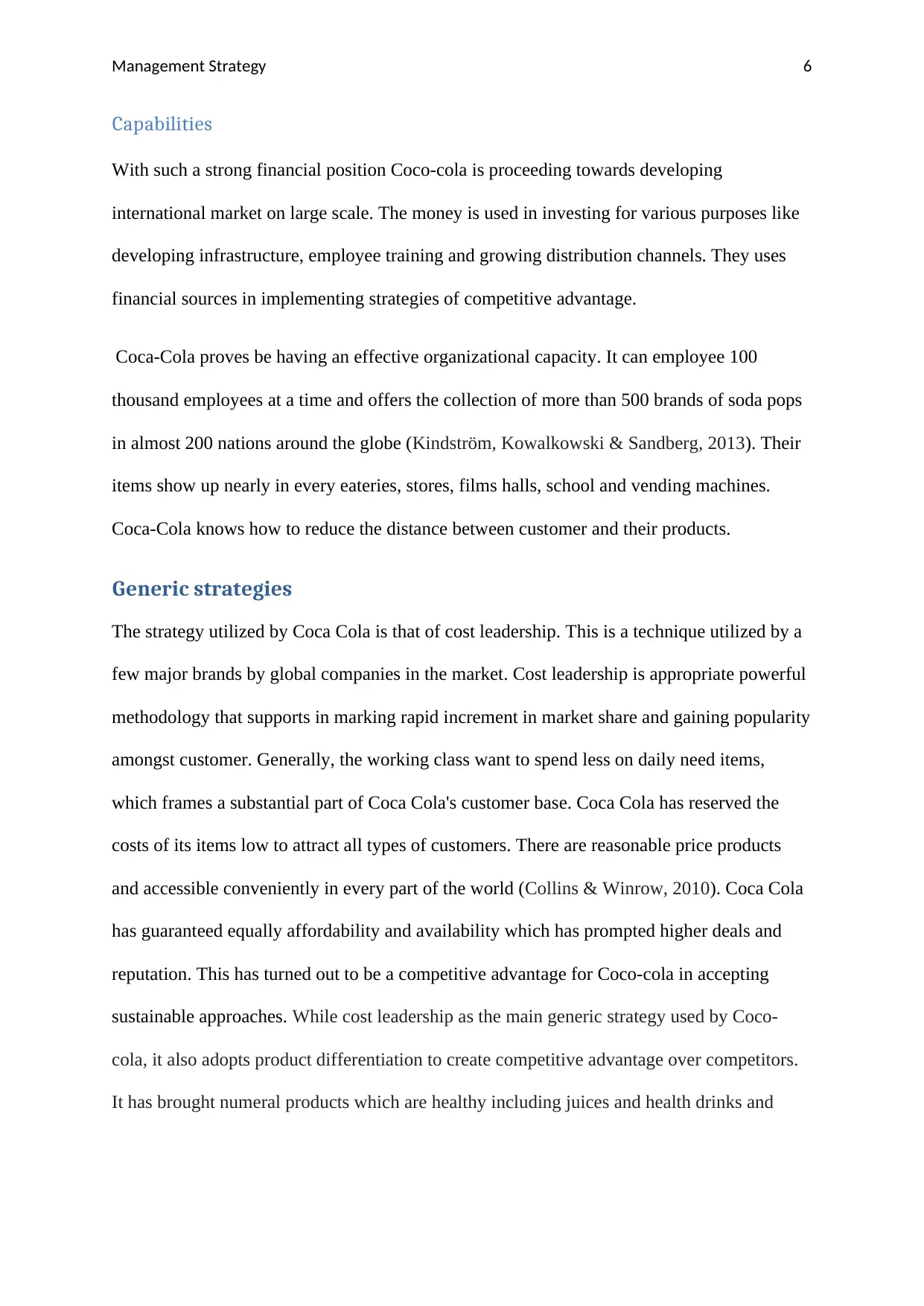
Management Strategy 6
Capabilities
With such a strong financial position Coco-cola is proceeding towards developing
international market on large scale. The money is used in investing for various purposes like
developing infrastructure, employee training and growing distribution channels. They uses
financial sources in implementing strategies of competitive advantage.
Coca-Cola proves be having an effective organizational capacity. It can employee 100
thousand employees at a time and offers the collection of more than 500 brands of soda pops
in almost 200 nations around the globe (Kindström, Kowalkowski & Sandberg, 2013). Their
items show up nearly in every eateries, stores, films halls, school and vending machines.
Coca-Cola knows how to reduce the distance between customer and their products.
Generic strategies
The strategy utilized by Coca Cola is that of cost leadership. This is a technique utilized by a
few major brands by global companies in the market. Cost leadership is appropriate powerful
methodology that supports in marking rapid increment in market share and gaining popularity
amongst customer. Generally, the working class want to spend less on daily need items,
which frames a substantial part of Coca Cola's customer base. Coca Cola has reserved the
costs of its items low to attract all types of customers. There are reasonable price products
and accessible conveniently in every part of the world (Collins & Winrow, 2010). Coca Cola
has guaranteed equally affordability and availability which has prompted higher deals and
reputation. This has turned out to be a competitive advantage for Coco-cola in accepting
sustainable approaches. While cost leadership as the main generic strategy used by Coco-
cola, it also adopts product differentiation to create competitive advantage over competitors.
It has brought numeral products which are healthy including juices and health drinks and
Capabilities
With such a strong financial position Coco-cola is proceeding towards developing
international market on large scale. The money is used in investing for various purposes like
developing infrastructure, employee training and growing distribution channels. They uses
financial sources in implementing strategies of competitive advantage.
Coca-Cola proves be having an effective organizational capacity. It can employee 100
thousand employees at a time and offers the collection of more than 500 brands of soda pops
in almost 200 nations around the globe (Kindström, Kowalkowski & Sandberg, 2013). Their
items show up nearly in every eateries, stores, films halls, school and vending machines.
Coca-Cola knows how to reduce the distance between customer and their products.
Generic strategies
The strategy utilized by Coca Cola is that of cost leadership. This is a technique utilized by a
few major brands by global companies in the market. Cost leadership is appropriate powerful
methodology that supports in marking rapid increment in market share and gaining popularity
amongst customer. Generally, the working class want to spend less on daily need items,
which frames a substantial part of Coca Cola's customer base. Coca Cola has reserved the
costs of its items low to attract all types of customers. There are reasonable price products
and accessible conveniently in every part of the world (Collins & Winrow, 2010). Coca Cola
has guaranteed equally affordability and availability which has prompted higher deals and
reputation. This has turned out to be a competitive advantage for Coco-cola in accepting
sustainable approaches. While cost leadership as the main generic strategy used by Coco-
cola, it also adopts product differentiation to create competitive advantage over competitors.
It has brought numeral products which are healthy including juices and health drinks and
⊘ This is a preview!⊘
Do you want full access?
Subscribe today to unlock all pages.

Trusted by 1+ million students worldwide

Management Strategy 7
aiming towards health of customer. So, Coca Cola has a mix of cost leadership and
differentiation to advance competitive advantage and to figure customer reliability.
Industry analysis
Porter five force model
Competitors force
Coco-cola is having the strong competition from rivalry. This component of Porter’s five
force model discloses the power of competitors present in market on each other. For Coco-
cola situation, this effect depends on the follwing elements.
1. High aggressiveness of firms (strong force)
2. Low switching cost (strong force)
Companies like PepsiCo, Cadbury, Fanta, Sprite and Schweppes compete with Coco-cola.
Such aggressiveness is detectable in technological development, forceful promoting, and
brand name loyalty. Then again, exchanging cost is low, which implies that it is simple for
customers to change from Coco-cola to different brands, in this manner making rivalry
significantly harder. Consequently, this part of the Five Forces model demonstrates that
competitive analysis is among the huge attentive point in Coco-cola strategy formation. For
more than a decade PepsiCo has been the strongest competitor for Coco-cola.
Bargaining power of buyer
The bargaining power of buyer is high in influencing Coco-cola’s business. In case of Coco-
cola buyer’s high bargaining power depends on two factors: Low switching cost size of
individuals. It is simple for customers to switch brands, consequently making them capable in
convincing establishments like Coco-cola to assure consumer satisfaction. On another side,
every buyer purchase is small in comparison to Coco-cola aggregate incomes. This situation
aiming towards health of customer. So, Coca Cola has a mix of cost leadership and
differentiation to advance competitive advantage and to figure customer reliability.
Industry analysis
Porter five force model
Competitors force
Coco-cola is having the strong competition from rivalry. This component of Porter’s five
force model discloses the power of competitors present in market on each other. For Coco-
cola situation, this effect depends on the follwing elements.
1. High aggressiveness of firms (strong force)
2. Low switching cost (strong force)
Companies like PepsiCo, Cadbury, Fanta, Sprite and Schweppes compete with Coco-cola.
Such aggressiveness is detectable in technological development, forceful promoting, and
brand name loyalty. Then again, exchanging cost is low, which implies that it is simple for
customers to change from Coco-cola to different brands, in this manner making rivalry
significantly harder. Consequently, this part of the Five Forces model demonstrates that
competitive analysis is among the huge attentive point in Coco-cola strategy formation. For
more than a decade PepsiCo has been the strongest competitor for Coco-cola.
Bargaining power of buyer
The bargaining power of buyer is high in influencing Coco-cola’s business. In case of Coco-
cola buyer’s high bargaining power depends on two factors: Low switching cost size of
individuals. It is simple for customers to switch brands, consequently making them capable in
convincing establishments like Coco-cola to assure consumer satisfaction. On another side,
every buyer purchase is small in comparison to Coco-cola aggregate incomes. This situation
Paraphrase This Document
Need a fresh take? Get an instant paraphrase of this document with our AI Paraphraser

Management Strategy 8
creates difficulty for customer at individual level. In this manner, the Five Forces model
demonstrates that Coco-cola must incorporate the buying power of customers as amongst the
most critical factors in creating strategies.
Bargaining power of supplier
Coco-cola is experiencing weak force in supplier’s bargaining power. The porter analysis
defines the power of supplier in imposing their requirements. In case of Coco-cola the
bargaining power of supplier is very weak because of high number of supplier and is hardly
any differentiation available.
Even though Company is having fewer suppliers for its components, as it is having huge
option to manage its suppliers from across the world. This situation creates difficult for
supplier to compel their demand on company. The higher number of supplier and lower cost
of switching creates convenience for company to switch to other suppliers. Thus, this factor
of porter model shows Coco-cola need not to sort out to bargaining power of supplier in
adopting strategies for leading industry and adopting innovation.
Threat of substitution
The chance of affecting business of Coco-cola due to substitution is very high. This factor of
Porter model determines the power of substitute product existing in alluring customers. In
case of Coco-cola, substitutes are exerting a strong force on the basis of high availability of
substitutes and same performance by substitutes (Dobbs, 2014).
The availability of substitutes for Coco-cola is from moderate to high. The substitute
products are Pepsi, Tea, coffee and many more. However effect of these substitutes on
performance of Coco-cola is very high due like nature of substitute product. These factors
shows Coco-cola is required to diversify its product in order to counter the rivalry. Moreover
company also need to prioritize the substitute’s threat in business function for marketing,
creates difficulty for customer at individual level. In this manner, the Five Forces model
demonstrates that Coco-cola must incorporate the buying power of customers as amongst the
most critical factors in creating strategies.
Bargaining power of supplier
Coco-cola is experiencing weak force in supplier’s bargaining power. The porter analysis
defines the power of supplier in imposing their requirements. In case of Coco-cola the
bargaining power of supplier is very weak because of high number of supplier and is hardly
any differentiation available.
Even though Company is having fewer suppliers for its components, as it is having huge
option to manage its suppliers from across the world. This situation creates difficult for
supplier to compel their demand on company. The higher number of supplier and lower cost
of switching creates convenience for company to switch to other suppliers. Thus, this factor
of porter model shows Coco-cola need not to sort out to bargaining power of supplier in
adopting strategies for leading industry and adopting innovation.
Threat of substitution
The chance of affecting business of Coco-cola due to substitution is very high. This factor of
Porter model determines the power of substitute product existing in alluring customers. In
case of Coco-cola, substitutes are exerting a strong force on the basis of high availability of
substitutes and same performance by substitutes (Dobbs, 2014).
The availability of substitutes for Coco-cola is from moderate to high. The substitute
products are Pepsi, Tea, coffee and many more. However effect of these substitutes on
performance of Coco-cola is very high due like nature of substitute product. These factors
shows Coco-cola is required to diversify its product in order to counter the rivalry. Moreover
company also need to prioritize the substitute’s threat in business function for marketing,
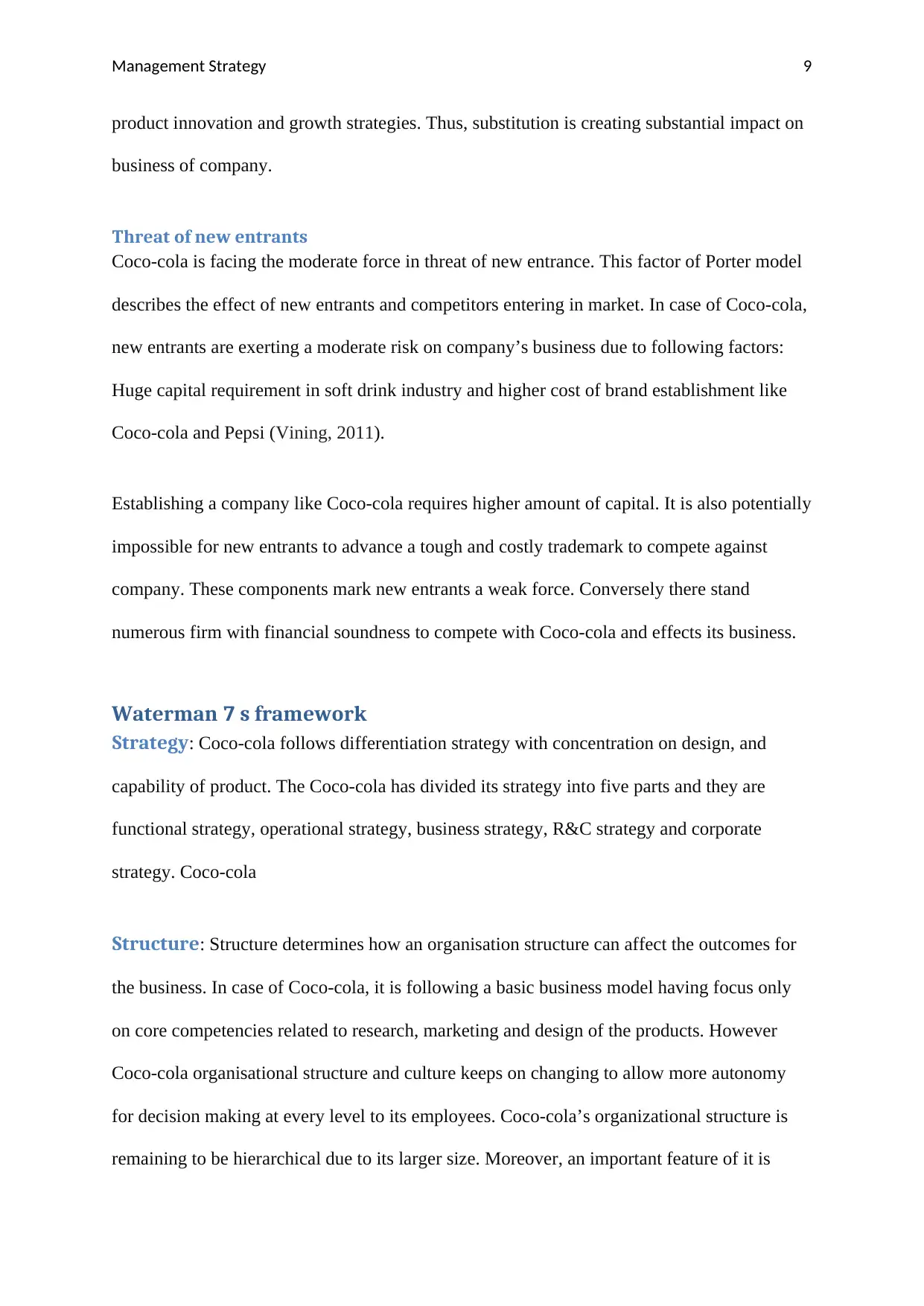
Management Strategy 9
product innovation and growth strategies. Thus, substitution is creating substantial impact on
business of company.
Threat of new entrants
Coco-cola is facing the moderate force in threat of new entrance. This factor of Porter model
describes the effect of new entrants and competitors entering in market. In case of Coco-cola,
new entrants are exerting a moderate risk on company’s business due to following factors:
Huge capital requirement in soft drink industry and higher cost of brand establishment like
Coco-cola and Pepsi (Vining, 2011).
Establishing a company like Coco-cola requires higher amount of capital. It is also potentially
impossible for new entrants to advance a tough and costly trademark to compete against
company. These components mark new entrants a weak force. Conversely there stand
numerous firm with financial soundness to compete with Coco-cola and effects its business.
Waterman 7 s framework
Strategy: Coco-cola follows differentiation strategy with concentration on design, and
capability of product. The Coco-cola has divided its strategy into five parts and they are
functional strategy, operational strategy, business strategy, R&C strategy and corporate
strategy. Coco-cola
Structure: Structure determines how an organisation structure can affect the outcomes for
the business. In case of Coco-cola, it is following a basic business model having focus only
on core competencies related to research, marketing and design of the products. However
Coco-cola organisational structure and culture keeps on changing to allow more autonomy
for decision making at every level to its employees. Coco-cola’s organizational structure is
remaining to be hierarchical due to its larger size. Moreover, an important feature of it is
product innovation and growth strategies. Thus, substitution is creating substantial impact on
business of company.
Threat of new entrants
Coco-cola is facing the moderate force in threat of new entrance. This factor of Porter model
describes the effect of new entrants and competitors entering in market. In case of Coco-cola,
new entrants are exerting a moderate risk on company’s business due to following factors:
Huge capital requirement in soft drink industry and higher cost of brand establishment like
Coco-cola and Pepsi (Vining, 2011).
Establishing a company like Coco-cola requires higher amount of capital. It is also potentially
impossible for new entrants to advance a tough and costly trademark to compete against
company. These components mark new entrants a weak force. Conversely there stand
numerous firm with financial soundness to compete with Coco-cola and effects its business.
Waterman 7 s framework
Strategy: Coco-cola follows differentiation strategy with concentration on design, and
capability of product. The Coco-cola has divided its strategy into five parts and they are
functional strategy, operational strategy, business strategy, R&C strategy and corporate
strategy. Coco-cola
Structure: Structure determines how an organisation structure can affect the outcomes for
the business. In case of Coco-cola, it is following a basic business model having focus only
on core competencies related to research, marketing and design of the products. However
Coco-cola organisational structure and culture keeps on changing to allow more autonomy
for decision making at every level to its employees. Coco-cola’s organizational structure is
remaining to be hierarchical due to its larger size. Moreover, an important feature of it is
⊘ This is a preview!⊘
Do you want full access?
Subscribe today to unlock all pages.

Trusted by 1+ million students worldwide

Management Strategy 10
represented by project based teams. This structure is adopted to satisfy more customer need
and demands. Coco-cola also owns regional structure focusing on both centralisation and
decentralisation.
Systems: System is the way through which activities and procedures are planned with a
specific end goal to finish the task to be done in a company. Coco-cola business operations
depend on variety of frameworks that incorporate but not restricted to employee recruitment
and enrolment, IT, fund and worker execution evaluation and others. The business process of
company is focusing specifically on strategic activities and processes important for company.
It enables Coco-cola to come out from competition and deliver best results to its customers.
Coco-cola also possess directional and management system to control the various activities of
company. Both systems ensure the importance of feedback, incentives and rewards to
organization.
Shared value: It can be defined as the centre value of an organization, which will influence
the way of life of that specific company. Some of the shared values adopted by Coco-cola are
sustainable development of society, support in healthy living, developing secure workplace,
and lessen the environmental impacts (Singh, 2013). At that point, it is very simple to
evaluate that the shared values really impact the strategy adopted by Coco-cola. The major
values adopted by Coco-cola towards CSR are recycling of used bottles, innovative
distribution, sustainable packaging and water stewardship.
Skills: It can be understood as competencies existing amongst employees and organization.
In case of Coco-cola, there are many factors attributing to success of Coco-cola. These are
called ‘skills’ which is possessed by company leading company to remarkable amount of
success across the world. Following are the skills possessed by Coco-cola:
represented by project based teams. This structure is adopted to satisfy more customer need
and demands. Coco-cola also owns regional structure focusing on both centralisation and
decentralisation.
Systems: System is the way through which activities and procedures are planned with a
specific end goal to finish the task to be done in a company. Coco-cola business operations
depend on variety of frameworks that incorporate but not restricted to employee recruitment
and enrolment, IT, fund and worker execution evaluation and others. The business process of
company is focusing specifically on strategic activities and processes important for company.
It enables Coco-cola to come out from competition and deliver best results to its customers.
Coco-cola also possess directional and management system to control the various activities of
company. Both systems ensure the importance of feedback, incentives and rewards to
organization.
Shared value: It can be defined as the centre value of an organization, which will influence
the way of life of that specific company. Some of the shared values adopted by Coco-cola are
sustainable development of society, support in healthy living, developing secure workplace,
and lessen the environmental impacts (Singh, 2013). At that point, it is very simple to
evaluate that the shared values really impact the strategy adopted by Coco-cola. The major
values adopted by Coco-cola towards CSR are recycling of used bottles, innovative
distribution, sustainable packaging and water stewardship.
Skills: It can be understood as competencies existing amongst employees and organization.
In case of Coco-cola, there are many factors attributing to success of Coco-cola. These are
called ‘skills’ which is possessed by company leading company to remarkable amount of
success across the world. Following are the skills possessed by Coco-cola:
Paraphrase This Document
Need a fresh take? Get an instant paraphrase of this document with our AI Paraphraser
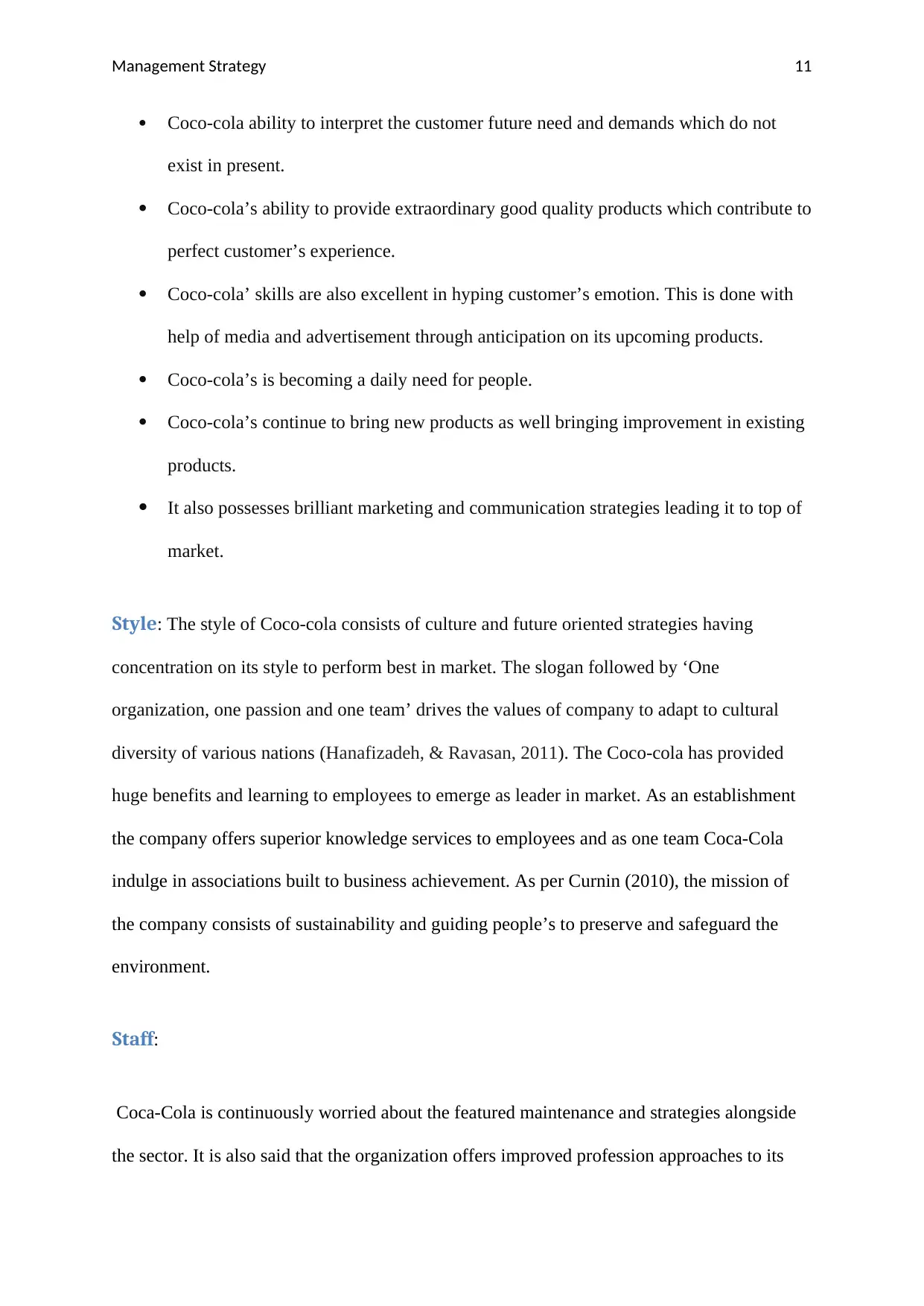
Management Strategy 11
Coco-cola ability to interpret the customer future need and demands which do not
exist in present.
Coco-cola’s ability to provide extraordinary good quality products which contribute to
perfect customer’s experience.
Coco-cola’ skills are also excellent in hyping customer’s emotion. This is done with
help of media and advertisement through anticipation on its upcoming products.
Coco-cola’s is becoming a daily need for people.
Coco-cola’s continue to bring new products as well bringing improvement in existing
products.
It also possesses brilliant marketing and communication strategies leading it to top of
market.
Style: The style of Coco-cola consists of culture and future oriented strategies having
concentration on its style to perform best in market. The slogan followed by ‘One
organization, one passion and one team’ drives the values of company to adapt to cultural
diversity of various nations (Hanafizadeh, & Ravasan, 2011). The Coco-cola has provided
huge benefits and learning to employees to emerge as leader in market. As an establishment
the company offers superior knowledge services to employees and as one team Coca-Cola
indulge in associations built to business achievement. As per Curnin (2010), the mission of
the company consists of sustainability and guiding people’s to preserve and safeguard the
environment.
Staff:
Coca-Cola is continuously worried about the featured maintenance and strategies alongside
the sector. It is also said that the organization offers improved profession approaches to its
Coco-cola ability to interpret the customer future need and demands which do not
exist in present.
Coco-cola’s ability to provide extraordinary good quality products which contribute to
perfect customer’s experience.
Coco-cola’ skills are also excellent in hyping customer’s emotion. This is done with
help of media and advertisement through anticipation on its upcoming products.
Coco-cola’s is becoming a daily need for people.
Coco-cola’s continue to bring new products as well bringing improvement in existing
products.
It also possesses brilliant marketing and communication strategies leading it to top of
market.
Style: The style of Coco-cola consists of culture and future oriented strategies having
concentration on its style to perform best in market. The slogan followed by ‘One
organization, one passion and one team’ drives the values of company to adapt to cultural
diversity of various nations (Hanafizadeh, & Ravasan, 2011). The Coco-cola has provided
huge benefits and learning to employees to emerge as leader in market. As an establishment
the company offers superior knowledge services to employees and as one team Coca-Cola
indulge in associations built to business achievement. As per Curnin (2010), the mission of
the company consists of sustainability and guiding people’s to preserve and safeguard the
environment.
Staff:
Coca-Cola is continuously worried about the featured maintenance and strategies alongside
the sector. It is also said that the organization offers improved profession approaches to its
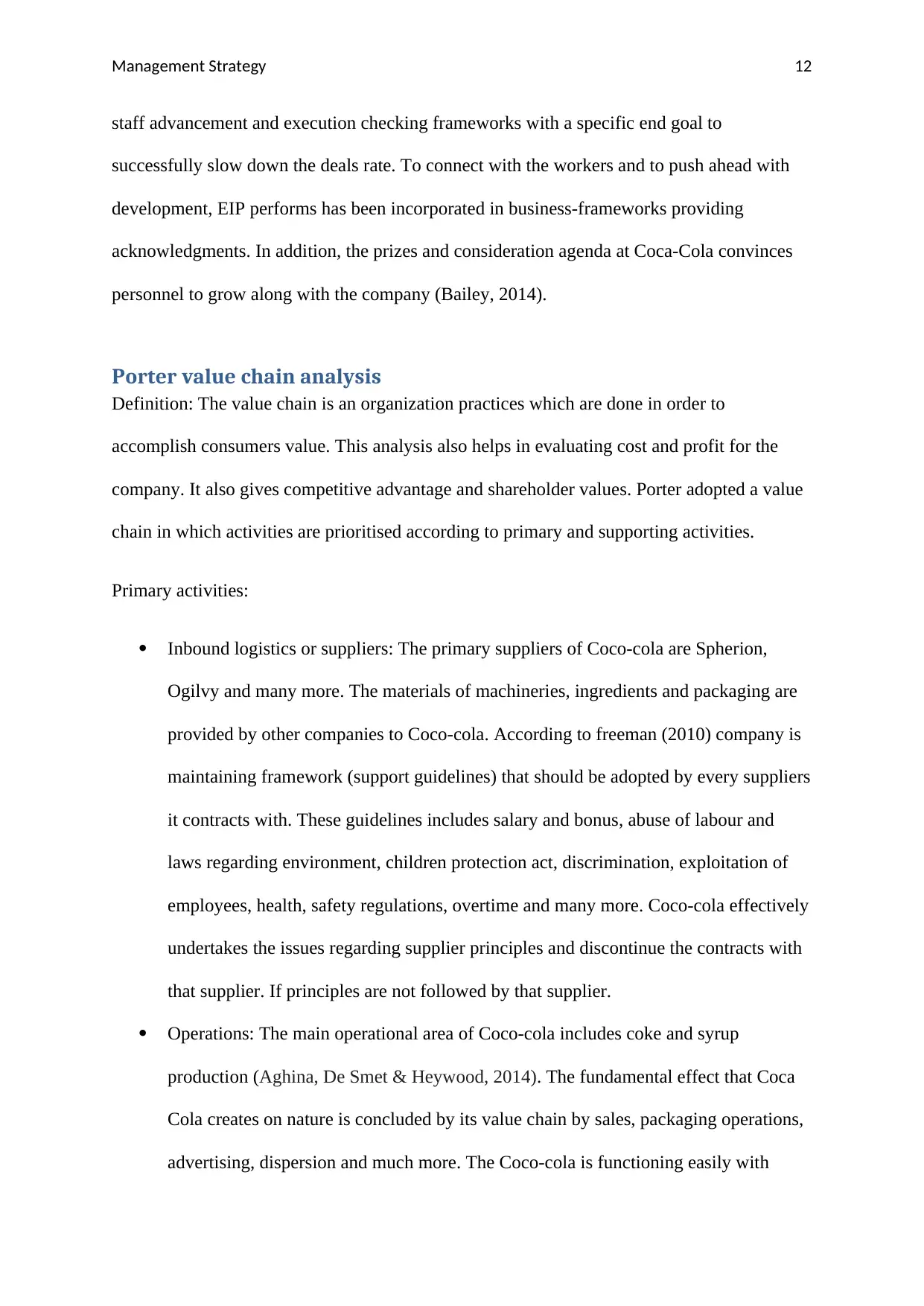
Management Strategy 12
staff advancement and execution checking frameworks with a specific end goal to
successfully slow down the deals rate. To connect with the workers and to push ahead with
development, EIP performs has been incorporated in business-frameworks providing
acknowledgments. In addition, the prizes and consideration agenda at Coca-Cola convinces
personnel to grow along with the company (Bailey, 2014).
Porter value chain analysis
Definition: The value chain is an organization practices which are done in order to
accomplish consumers value. This analysis also helps in evaluating cost and profit for the
company. It also gives competitive advantage and shareholder values. Porter adopted a value
chain in which activities are prioritised according to primary and supporting activities.
Primary activities:
Inbound logistics or suppliers: The primary suppliers of Coco-cola are Spherion,
Ogilvy and many more. The materials of machineries, ingredients and packaging are
provided by other companies to Coco-cola. According to freeman (2010) company is
maintaining framework (support guidelines) that should be adopted by every suppliers
it contracts with. These guidelines includes salary and bonus, abuse of labour and
laws regarding environment, children protection act, discrimination, exploitation of
employees, health, safety regulations, overtime and many more. Coco-cola effectively
undertakes the issues regarding supplier principles and discontinue the contracts with
that supplier. If principles are not followed by that supplier.
Operations: The main operational area of Coco-cola includes coke and syrup
production (Aghina, De Smet & Heywood, 2014). The fundamental effect that Coca
Cola creates on nature is concluded by its value chain by sales, packaging operations,
advertising, dispersion and much more. The Coco-cola is functioning easily with
staff advancement and execution checking frameworks with a specific end goal to
successfully slow down the deals rate. To connect with the workers and to push ahead with
development, EIP performs has been incorporated in business-frameworks providing
acknowledgments. In addition, the prizes and consideration agenda at Coca-Cola convinces
personnel to grow along with the company (Bailey, 2014).
Porter value chain analysis
Definition: The value chain is an organization practices which are done in order to
accomplish consumers value. This analysis also helps in evaluating cost and profit for the
company. It also gives competitive advantage and shareholder values. Porter adopted a value
chain in which activities are prioritised according to primary and supporting activities.
Primary activities:
Inbound logistics or suppliers: The primary suppliers of Coco-cola are Spherion,
Ogilvy and many more. The materials of machineries, ingredients and packaging are
provided by other companies to Coco-cola. According to freeman (2010) company is
maintaining framework (support guidelines) that should be adopted by every suppliers
it contracts with. These guidelines includes salary and bonus, abuse of labour and
laws regarding environment, children protection act, discrimination, exploitation of
employees, health, safety regulations, overtime and many more. Coco-cola effectively
undertakes the issues regarding supplier principles and discontinue the contracts with
that supplier. If principles are not followed by that supplier.
Operations: The main operational area of Coco-cola includes coke and syrup
production (Aghina, De Smet & Heywood, 2014). The fundamental effect that Coca
Cola creates on nature is concluded by its value chain by sales, packaging operations,
advertising, dispersion and much more. The Coco-cola is functioning easily with
⊘ This is a preview!⊘
Do you want full access?
Subscribe today to unlock all pages.

Trusted by 1+ million students worldwide
1 out of 17
Related Documents
Your All-in-One AI-Powered Toolkit for Academic Success.
+13062052269
info@desklib.com
Available 24*7 on WhatsApp / Email
![[object Object]](/_next/static/media/star-bottom.7253800d.svg)
Unlock your academic potential
Copyright © 2020–2025 A2Z Services. All Rights Reserved. Developed and managed by ZUCOL.



